Finding the right way to organize your daily tasks can make a huge difference in your productivity and peace of mind. To help you navigate the sea of options available today, we’ve compiled a list of the 10 best daily planner apps in 2025. Let’s explore which one might be the perfect fit for you.
The best daily planner apps at a glance
| App | Key features | Platforms | Price |
|---|---|---|---|
| Notion | All-in-one productivity, databases, AI, templates, real-time collaboration | Web, Windows, Mac, iOS, Android | Free | Plus: $12/month |
| Todoist | Intuitive UI, subtasks, recurring tasks, gamification (Karma), custom labels | Web, Windows, Mac, Linux, iOS, Android | Free | Pro: $5/month |
| Google Calendar | Google Workspace integration, recurring scheduling, calendar sharing | Web, iOS, Android | Free |
| Trello | Kanban project management, to-do lists, drag-and-drop, real-time collaboration | Web, Windows, Mac, iOS, Android | Free | Standard: $5/month |
| Things 3 | Beautiful design, to-do lists, email tasks, calendar integration, reminders | Mac, iOS, Apple Watch | $9.99 (one-time) |
| Evernote | Handwritten notes, OCR, audio notes, web clipper, powerful search | Web, Windows, Mac, iOS, Android | Free | Personal: $14.99/month |
| Microsoft Outlook | Email, tasks, scheduling, Microsoft 365 integration, Copilot AI | Web, Windows, Mac, iOS, Android | Free | Microsoft 365 Personal: $9.99/month |
| Fantastical | Smart suggestions, scheduling, Zoom integration, calendar sets, widgets | Web, iPhone, iPad, Mac, Apple Watch | Free | Premium: $6.99/month |
| TickTick | Pomodoro timer, gamified productivity, multiple calendar views, smart lists | Web, Windows, Mac, Linux, iOS, Android, Apple Watch | Free | Premium: $35.99/year |
| Microsoft To Do | Task tracking, reminders, simple UI, sync with Microsoft Office 365 | Web, Windows, Mac, iOS, Android | Free |
1. Notion

✅ Pros:
- All-in-one productivity suite
- Highly-customizable databases, templates, and views
- Intuitive drag-and-drop user experience
- Cross-functional collaboration
- AI support
❌ Cons:
- High learning curve
- Some features can feel overwhelming
💻 Platforms: Web, Windows, Mac, iOS, Android
💲 Price: Free | Plus: $12/monthly
Notion shines as one of the best daily planner apps thanks to its revolutionary amalgam of productivity features. Unlike traditional planners, Notion consolidates several functions, including more than 40 content types to tailor your workspace, wikis, docs, and notes, unlimited pages and blocks, highly customizable templates, recurring tasks, real-time collaboration, a native calendar, and AI support.
2. Todoist
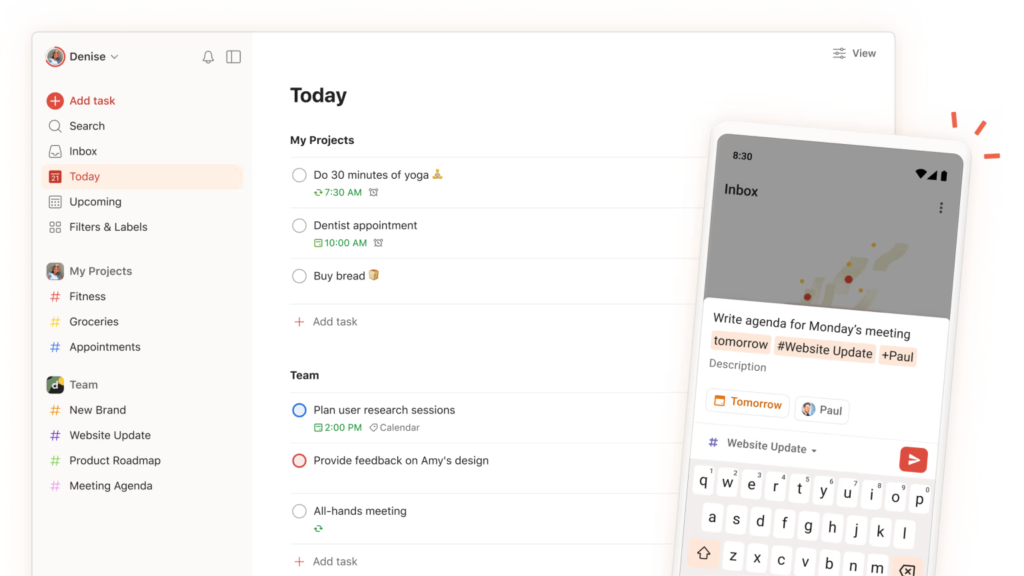
✅ Pros:
- Easy to use
- Beautiful interface
- Good integrations
- Recurring tasks
- Useful iPhone widget
❌ Cons:
- Lack of advanced features and customization
- Might not be suitable for complex project management
💻 Platforms: Web, Windows, Mac, Linux, iOS, Android
💲 Price: Free | Pro: $5/month
Todoist streamlines task management with its intuitive interface and powerful features, including subtasks, recurring tasks, and custom labels, allowing for precise organization. Its flexibility caters to diverse needs, from daily checklists to complex projects, while seamless integrations boost productivity. The Karma system gamifies productivity, adding a motivating element to your organizational routine.
👉 Learn more: Notion vs. Todoist: Which Is the Best? [2025]
3. Google Calendar

✅ Pros:
- Intuitive interface
- Google Tasks integration
- Seamless management of different calendars
- Calendar sharing
❌ Cons:
- Mobile UI could be less confusing when managing multiple calendars
- Calendars with lots of subscriptions can look muddled
💻 Platforms: Web, iOS, Android
💲 Price: Free
Google Calendar stands out as a premier daily planner due to its seamless integration with Google Workspace apps and expansive features. Users can easily preview their schedules, monitor goals, manage routines with recurring event scheduling, and enhance visual engagement by adding images and maps. With its automatic updates from Gmail, like flight and hotel details, it’s ideal for both individuals and teams, catering particularly to students and professionals.
4. Trello
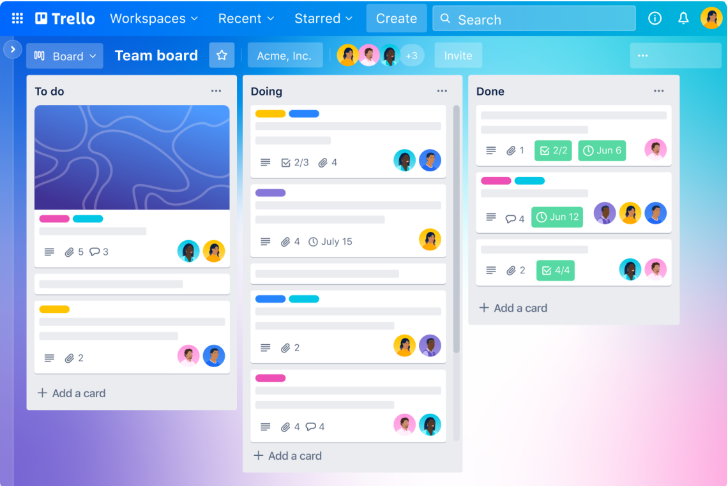
✅ Pros:
- To-do lists with steps and due dates
- Intuitive drag-and-drop feature
- Ideal for large teams
❌ Cons:
- It’s easy to move or delete a card mistakenly
- It’s not as customizable as other tools
💻 Platforms: Web, Windows, Mac, iOS, Android
💲 Price: Free | Standard: $5/month
Trello’s innovative Kanban style of project management, combined with its efficient design and intuitive interface, has successfully steered it to the top of the charts. You can efficiently track to-do lists, set due dates, or delegate tasks. Collaboration is made effortless; invite anyone and work together seamlessly. The platform facilitates real-time discussion with its instant messaging feature.
5. Things 3
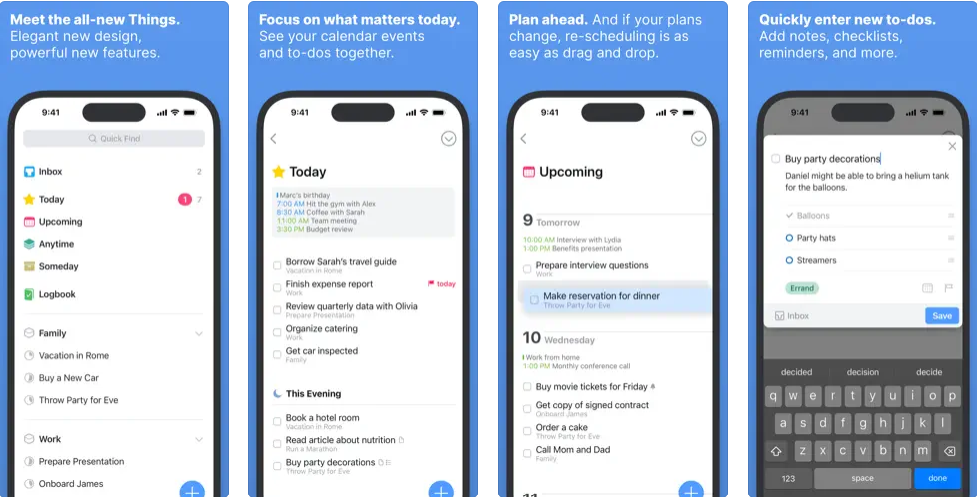
✅ Pros:
- Create to-do lists by sending an email
- Recurring tasks
- Reminders
- Calendar integration
- Beautiful widgets
❌ Cons:
- Only available on Apple products
- No collaboration features
- No free version
- No web app
💻 Platforms: Mac, iOS, Apple Watch
💲 Price: $9.99
Things 3 is one of the best daily planner apps for iOS devices due to its incredibly user-friendly interface and versatile functionality. Not only does it have a visually appealing design, but it also offers an array of valuable features, such as interactive to-do lists, checklists, notes, drag-and-drop rescheduling, reminders, and repeaters.
6. Evernote

✅ Pros:
- Handwritten notes
- Speech-to-text and audio record
- Excellent organizer for reading lists and permanent notes
- Tasks, subtasks, folders, and lists
- Powerful search feature
- Optical character recognition (OCR)
❌ Cons:
- The interface can seem a bit outdated
- The free account has a limitation of 60MB per month
- Premium plans are costly
💻 Platforms: Web, Windows, Mac, iOS, Android
💲 Price: Free | Personal: $14.99/month
Evernote stands as one of the best planner apps and organizers. It harnesses robust features to optimize your productivity and effortlessly keep tasks on track with handwritten notes, voice notes, integrations, custom templates, reminders, and offline access. At the same time, the Web Clipper browser extension lets you capture and save web pages, pictures, and text when surfing the internet.
👇 Explore: Notion vs. Evernote
7. Microsoft Outlook
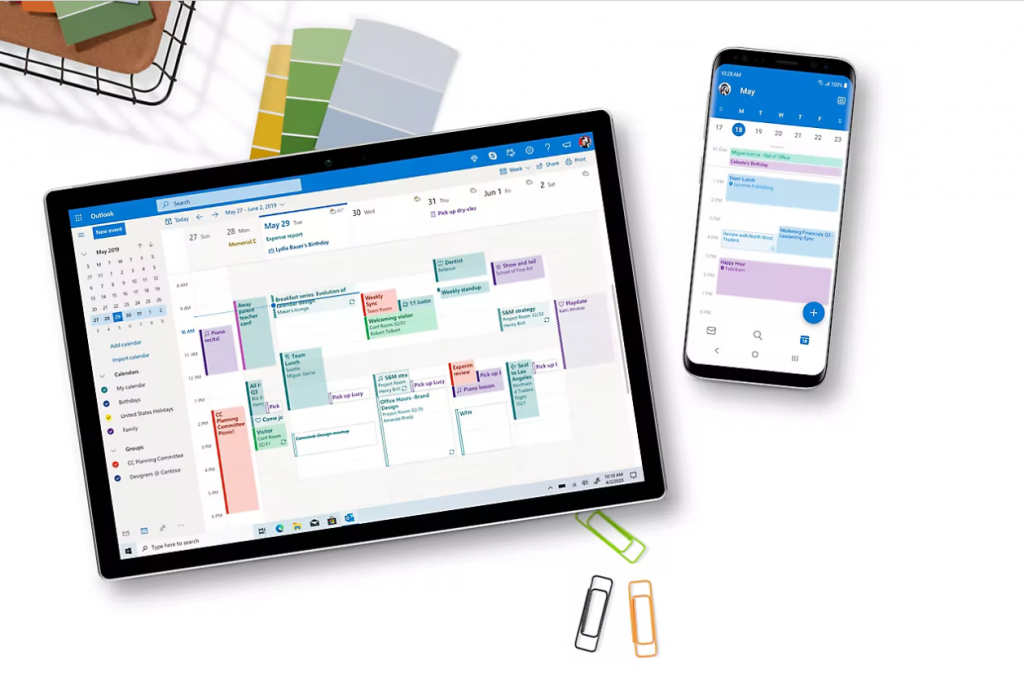
✅ Pros:
- Email, tasks, and events scheduling
- Calendar sharing
- Collaboration with Microsoft 365 groups
- Advanced filtering
- Microsoft Office on the go
- Copilot AI
❌ Cons:
- The interface is cluttered with too many features
- Poor app user experience
💻 Platforms: Web, Windows, Mac, iOS, Android
💲 Price: Free | Microsoft 365 Personal: $9.99/month
Microsoft Outlook can function daily planner app offering various features. Users can access Office tools easily, and its task management system allows for efficient finding, filtering, grouping, and overseeing of tasks. The app integrates with Microsoft 365 Groups, facilitating team collaboration. Its scheduling functions assist in organizing tasks, events, and emails. Additionally, Microsoft’s Copilot AI is available as a virtual assistant to help you with your daily tasks.
8. Fantastical

✅ Pros:
- Beautiful UI
- Intelligent suggestions
- Easy integration with multiple tools and accounts
- Useful widgets
- Reliable customer support
❌ Cons:
- Costly subscription model
- Only available on Apple devices
💻 Platforms: Web, iPhone, iPad, Mac, Apple Watch
💲 Price: Free | Premium: $6.99/month
Fantastical is an awarded calendar app for Apple devices with management features and useful widgets. You can change the views of the calendar to show your day, week, month, or year and plan tasks and events using templates. It’s built with centralization in mind, so there’s no need to leave the app to integrate other tools, such as when adding a Zoom link to an event you create. Among others, it has a scheduling feature, calendar sets, focus filters, and file attachments for tasks.
9. TickTick
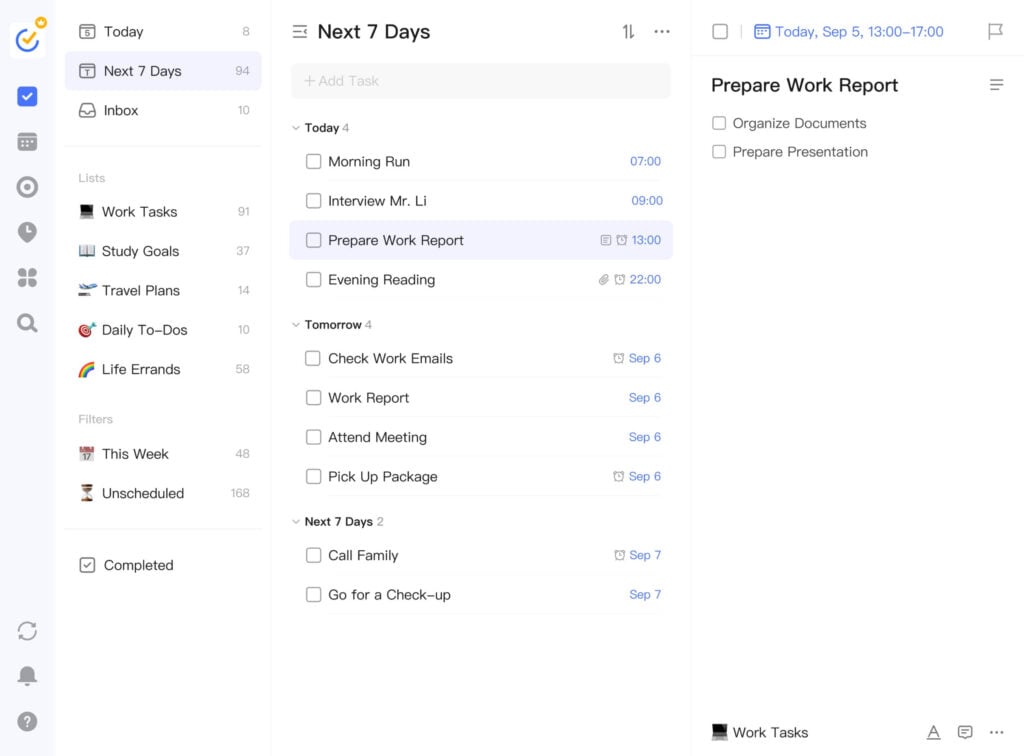
✅ Pros:
- Pomodoro timer for better focus
- Gamification of productivity with achievement scores
- It works and syncs with multiple devices
- Fairly cheap
❌ Cons:
- No advanced features like tasks time tracking
- Reports of occasional missing data when syncing
💻 Platforms: Web, Windows, Mac, Linux, iOS, Android, Apple Watch
💲 Price: Free | Premium: $35.99/yearly
TickTick offers smart task lists and filters for optimal task prioritization, a Pomodoro timer for efficient time management, multiple calendar views for clear visualization of your schedule, and the achievement score and statistics to monitor productivity trends. Moreover, calendar subscriptions keep you in the loop about crucial events.
👉 Learn more: TickTick vs. Todoist: Which To-Do List App Is Better?
10. Microsoft To Do
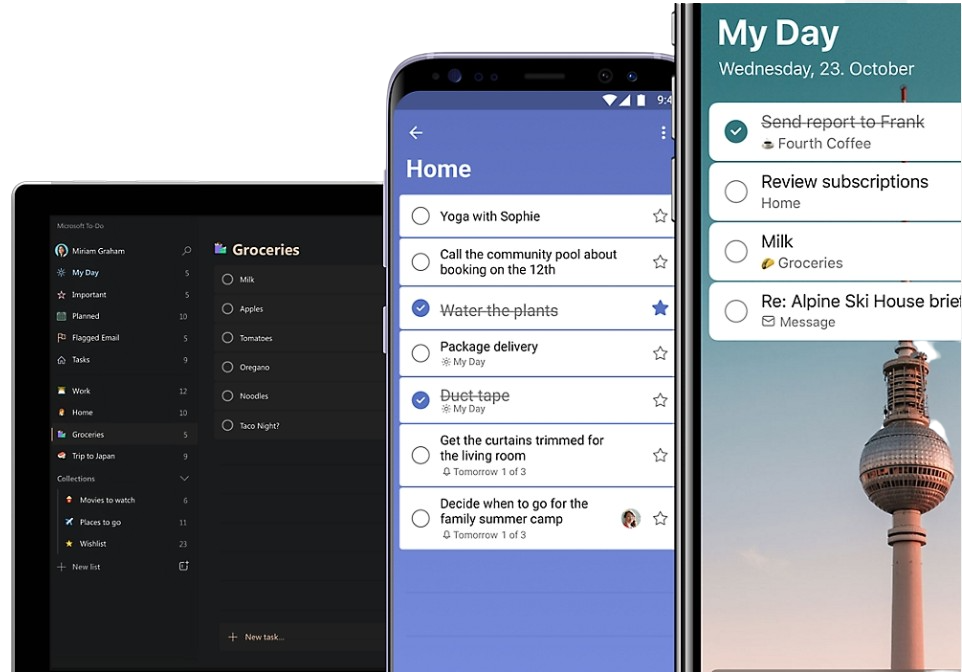
✅ Pros:
- Monitoring of pending tasks
- Simple to navigate
- Easy task tracking
- Daily view
- Reminders
- Syncs with Microsoft Office 365
❌ Cons:
- It could be easier to edit and assign tasks
- Overdue tasks could be more easily managed
- No third-party logins (Google, LinkedIn, Apple)
💻 Platforms: Web, Windows, Mac, iOS, Android
💲 Price: Free
Microsoft To Do is a noteworthy planner app that evolved from the well-liked Wunderlist with enhanced user-friendly features. It offers a “Yesterday” box to monitor pending tasks, ensuring no task is missed. Users can organize tasks under specific lists such as “Work” or “Home” and further detail them with subtasks. The app boasts a user-friendly interface, allowing for preferences like dark mode and the selection of motivating background designs for lists.
Conclusion
Picking one of the best planner apps on this list depends on your preferences and needs. Some are all-in-one productivity suites that can manage simple and complex workflows with multiple databases, libraries, and customizable templates, such as Notion. Others are aimed at users who need simpler interfaces with calendars or to-do lists, such as Todoist.
👉 Related article: 10 Best Free Online Planners
You may also benefit from integrating and syncing different tools for better productivity and convenience. That’s why we created 2sync.
Our automations can help you integrate different tasks, lists, data, and workspaces from and to multiple tools like Notion so you can have everything in one place in a complete full 2-way sync.


